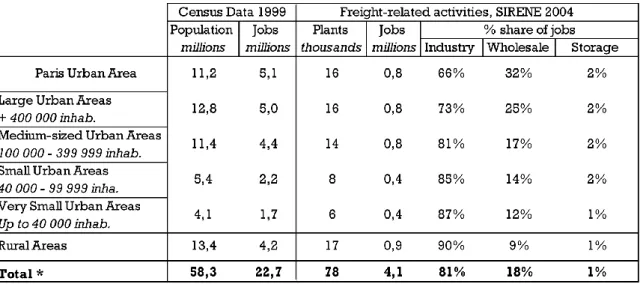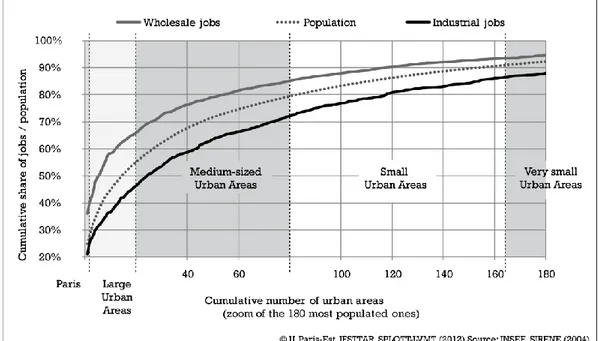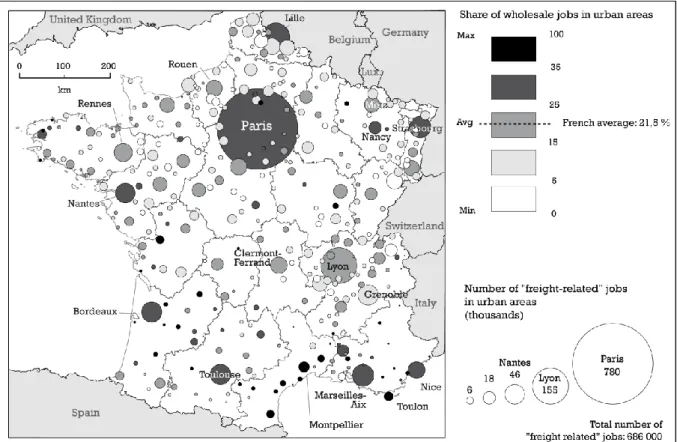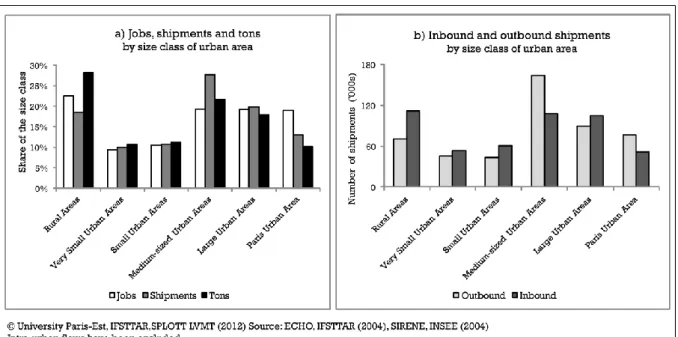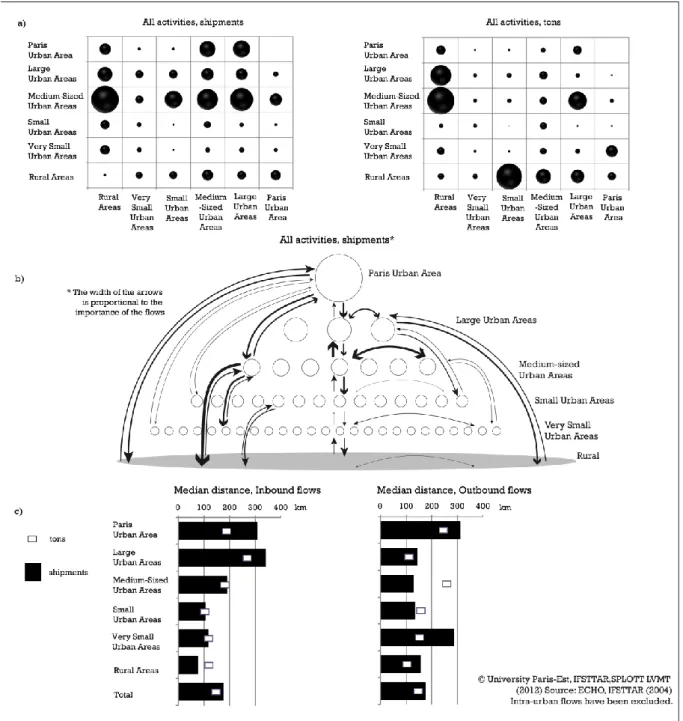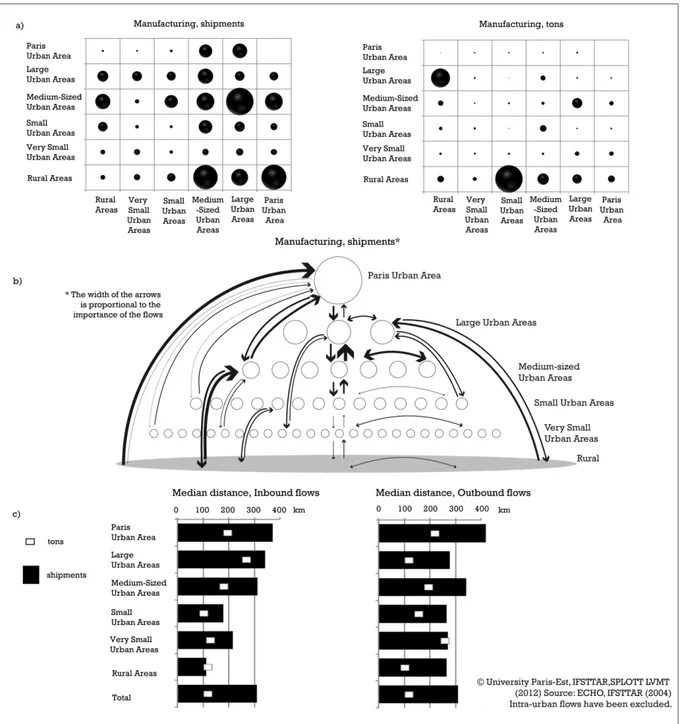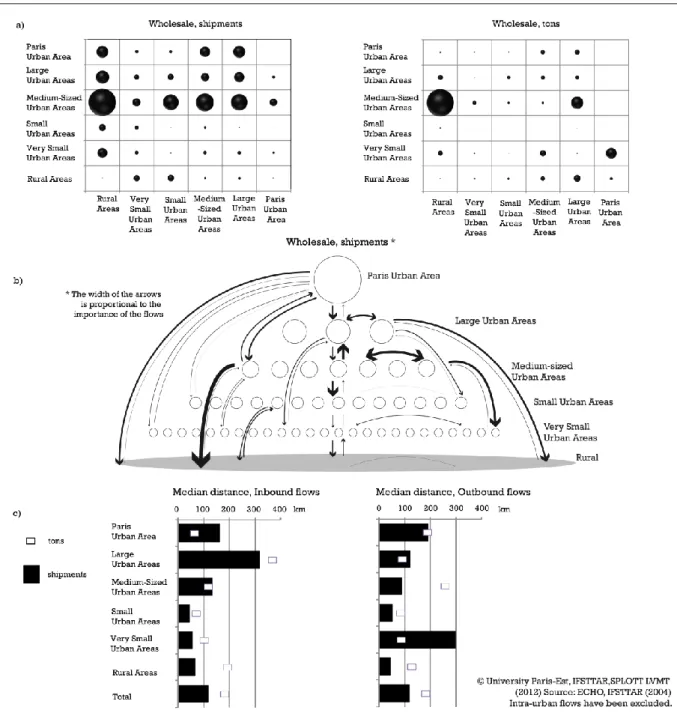HAL Id: halshs-00748231
https://halshs.archives-ouvertes.fr/halshs-00748231
Preprint submitted on 5 Nov 2012HAL is a multi-disciplinary open access
archive for the deposit and dissemination of sci-entific research documents, whether they are pub-lished or not. The documents may come from teaching and research institutions in France or abroad, or from public or private research centers.
L’archive ouverte pluridisciplinaire HAL, est destinée au dépôt et à la diffusion de documents scientifiques de niveau recherche, publiés ou non, émanant des établissements d’enseignement et de recherche français ou étrangers, des laboratoires publics ou privés.
David Guerrero, Laurent Proulhac
To cite this version:
1
FREIGHT FLOWS AND URBAN
HIERARCHY: SOME EVIDENCE FROM
FRANCE
David GUERRERO, University Paris EST, IFSTTAR, SPLOTT, david.guerrero@ifsttar.fr Laurent PROULHAC, University Paris EST, IFSTTAR, LVMT, laurent.proulhac@enpc.fr
ABSTRACT
This paper considers the varying hierarchy of freight flows between urban areas, distinguishing between manufacturing and wholesale trade activities. It draws on the results of a French survey that describes shipments sent by firms. It shows that the pattern of freight flows between urban areas in France is hierarchical, but that it varies according to whether the flows are generated by wholesale trade activities or by manufacturing. The differences are explained by the specific organisational characteristics of each of these two activities. Wholesale trade broadly reflects the traditional spatial organization of service activities, with interlocking areas of influence. The spatial organization of manufacturing flows is more complex, and seems to be much more the result of regional specialisation of activities.
Keywords: freight transport, urban hierarchy, manufacturing, wholesale trade, France
1. INTRODUCTION
Towns and cities are not isolated entities. They maintain intense relations with their hinterlands and with other urban entities. Numerous academic studies have focused on the analysis of these relations. In explaining the interconnections between urban entities, authors often employ two contrasting concepts: the hierarchy and the network.
The concept of an urban hierarchy implies that relations between cities have a pyramid structure, with interlocking subsystems. Proposed in the first half of the 20th century by Christaller, it was mainly developed in the 1950s and 1960s through a number of national studies. In these studies, the urban hierarchy is analysed using two main information sources: stocks and networks. In the analysis from stocks, population and activities in cities are studied to identify thresholds that form the boundaries between the different levels of urban hierarchy (Berry and Garrisson, 1958). In the analysis from networks, cities are distinguished by the size of their areas of influence, and/or their position within systems of different kinds.
2
Transport networks studies: a partitioned approach of the urban hierarchy
Transport is a recurrent theme in many studies of urban hierarchy. In their quest to investigate the entire urban hierarchy, researchers tackle different means of transport separately. The work by Green (1958) in the UK and by Godlund (1956) in Sweden shows how towns are hierarchically structured by the coach network. Godlund also shows that the position of individual Swedish towns within the coach network is strongly correlated with the diversity of economic activities present in those towns. These studies of coach links are rich in information about the organisation of the lowest levels of the urban hierarchy, because they can help to identify the boundaries of regional zones of influence. However, this type of approach has limitations when it comes to analysing the zones of influence of large cities, in so far as medium and long distance transport increasingly takes place by air. In this respect, the pioneering study by Taaffe (1962) on air links between US cities provides an excellent counterpart to the work on coach connections. It demonstrates the dominant role of New York, Chicago, Los Angeles and San Francisco in air links. It also shows the growth in direct air links between these four big airports and all the other cities. This leads to a marginalisation of many regional airports, which experience a weakening in their role as intermediaries between large and small airports. The decline of the intermediate level and the growth of the four main airports reveal the changing hierarchical organization of American cities.
Global city studies: a selective approach of the urban hierarchy
This same hierarchical model of interurban relations re-emerged more recently in the research field of global cities, on a less transport-based approach, mainly focused on the higher levels of hierarchy. Friedmann (1986), for example, showed how the development of multinational firms, with their international division of labour, has increased the gap between cities. In his approach, based on the number of headquarters located in each city, global cities are those that concentrate the “control” functions of multinational firms. Cities are then organized in categories depending on their ranking on the different sectors of world economy, mainly on advanced producer and financial services.
The hierarchical approach of global cities has been widely criticised by scholars in the last two decades. Castells (1996) argues that the global city phenomenon cannot be reduced to competition between big cities. According to him, non-hierarchical relationships of cooperation between cities become more and more important in the age of cyberspace and cannot be neglected. More globally, hierarchical approaches are criticised by the lack of empirical work specifying how hierarchical ties between cities are organized (Taylor, 2004, p.364):
“Nobody has provided data showing such a process and it is hard to imagine in what way, for instance, London as Europe’s ‘‘premier world city’’ tells other European cities, such as Paris and Frankfurt, what to do”.
3
Freight flows: towards a more inclusive and integrated approach of the urban
hierarchy
Contemporary studies of city systems mainly focus on the higher levels of urban hierarchy (i.e. global cities) and on control functions of multinational firms (i.e. advanced producer and financial services). Small and medium-sized towns and the other dimensions of economy like manufacturing and logistics remain clearly underrepresented, except in a few cases (Ducruet, 2012)
The purpose of this paper is to help to fill this void, by analysing the productive links between the higher and lower levels of urban hierarchy in France. To achieve this goal, it examines the nature and intensity of interurban freight flows in France. It paints a simplified picture of the geography of material flows, with regard to the light they shed on economic interactions between cities. However, beyond simply deploying a new indicator to analyse the relations between urban areas, the article seeks to elucidate the consequences and implications of the location of the system of production on the transport system.
The rest of this paper is structured as follows. The next section sets out our hypotheses and outlines the data and methods used. Section 3 analyses the location of the manufacturing industry and wholesale activities. Section 4 describes the distribution of freight flows between urban areas as it relates to their size. It proposes a macroscopic approach to examine the spatial organization of productive systems. The final section offers some concluding remarks and identifies main research priorities.
2. MEASURING INTERURBAN FREIGHT FLOWS: DATA AND
METHOD
The urban area as the unit of observation of interurban flows
In research on freight transport, the urban is often approached from a morphological perspective, i.e. with a focus on the zones of greatest density, where most of the congestion problems caused by deliveries occur (Patier, Routhier, 2009). This approach to the urban area emphasises the notion of building density. There has been less research attention to the urban margins, where deliveries cause fewer problems, but where a significant proportion of freight flows are nevertheless generated. Moreover, the sprawl of jobs (Huriot, 2004) and logistic activities (Dablanc, Andriankaja, 2011 ; Dablanc, Ross, 2012) in cities in recent years has led to an increase in inbound and outbound flows at out-of-town firms as a proportion of the total flows within the metropolitan area. As this paper looks at the question of interurban freight flows, its aim is significantly different from that of papers on urban logistics. What we are seeking to analyse here is not intra-urban movements between city centres and the outskirts, but rather the relations between different urban areas. We therefore felt it necessary to use a wider definition of the city, to include the urban outskirts, where many of the entities that generate flows are located. The definition of the urban perimeter in this paper is that used by INSEE (national institute of statistics and economic studies) and refers to the geographical definition of urban areas established in 1999. The urban area is an urban unit with more than 10,000 jobs, and periurban communities in which at least 40% of the resident
4
working population works within the central zone or in communities within its catchment area. In this research, the term “city” or “town” is often used instead of “urban area” for reasons of brevity.
Data on firms and flows
The empirical sources of the research are two national surveys of different but complementary character. First, the location of activities that generate freight flows is identified using the SIRENE database (2004), which provides a record of the plants and jobs of French firms. Then, freight flows are measured using the ECHO database (2004), which contains information on freight shippers and the characteristics of their shipments.
The first database employed in this article is the 2004 SIRENE survey carried out by INSEE, France’s national statistical institute. This unique and exhaustive database contains economic and spatial information on firms, their plants (physical facilities operated by a firm or government department) and their jobs by business sector (NAF – French classification of activities). The use of this survey to identify the location of economic activities within the national space is an essential preliminary to a detailed reading of the economic functioning of the flows generated by firms. The second database used, the 2004 national shipper survey ECHO, conducted by IFSTTAR (French Institute of Science and Technology for Transport, Development and Networks), provides rich material for the analysis of transport practices and their logistical determinants (Guilbault, M., Gouvernal, E., 2010). It provides a tool for observing demand by shippers and by physical and organisational transport chains leading from the shipper to the end consignee. The sample survey in the study consists of 2935 plants, 10,462 shipments and 9742 complete transport chains. The scope of the survey covers all firms in mainland France, excluding Corsica, with 10 employees or more, operating in wholesale trade, manufacturing (excluding the extractive industries and public works), mail-order sales, agricultural cooperatives, warehousing services and industrial waste processing centres. So in all it covers some 70,000 plants and estimated transport volumes after adjustment of 985 million metric tons and 738 million shipments (Guilbaut, Soppé, 2009).
Methodological choices
The fine stratification of the shipper survey by firm activity and size, means that its traffic data is statistically representative and it lends itself to economic breakdown into major production types. On the other hand, the sampling plan does not include a regional breakdown or origin-destination analysis. This means that the shipper survey does not represent shipments at the level of different urban areas. In order to overcome this deficiency, the cities where the firms shipping and receiving freight flows are located were aggregated into several categories (appendix A). They were broken down into five levels by size of urban area, ensuring that the total weight of each one was comparable in terms of population, jobs and shipments (table I): the Paris urban area, 18 large urban areas (400,000-1.6 million inhabitants), which include a dozen regional capitals “outside the Paris area”, 58 “medium-sized” urban areas (100,000-399,000 inhabitants), 85 small urban areas (40,000-99,000), 189 very small urban areas (under 40,000), and rural areas.
5
Identifying a hierarchy of urban areas (choice of population size)
Table I - Background data on urban areas, aggregated by size category
Measuring inter-urban freight flows: shipment and tonnage as measurement units
The originality and richness of the shipper survey means that the results can be presented for two complementary units of measurement: tonnage and shipment. Used alongside tonnage, the shipment provides an enhanced level of observation for reconstituting traffic chains and as a logistical indicator of shipper practices. Both these different levels of information are used in the article.
Still in terms of methodology, the nature, intensity, direction and scope of the interactions are explored. We chose to restrict our analysis of freight flows to the two ends of the shipping chain only, in other words to consider only the town or city of origin, at the level of the shipping firm, and the town or city of destination, at the level of the consignee firm. Intermediate logistics platforms in cities through which these shipments may transit are not included, because this is a question of logistics rather than production or consumption. Finally, when looking at the results, it should always be remembered that internal flows within urban areas are never included.
Distinguishing manufacturing and wholesale trade
In order to ensure that our findings were statistically representative from the territorial and economic point of view, and thereby to overcome the deficiency in the shipper survey’s source data, we aggregated the 36 sectors of activity covered in the survey into two sectors: wholesale trade and manufacturing.
The first sector notably includes wholesale trade in intermediate goods, wholesale trade in production and wholesale trade in consumer goods. Warehousing and mail-order sales are also included in wholesale trade. On the other hand, chemicals, speciality chemicals, metallurgy, waste processing, construction, object manufacturing, and the automotive, agri-food, pharmaceutical, etc. industries, are aggregated within the manufacturing sector. This division into two categories should not conceal the heterogeneity within the categories themselves. In order to avoid misinterpretations caused by this lack of homogeneity, we
6
made sure that the main components of each of the two categories (manufacturing and wholesale trade) are geographically linked. When this is not the case, for example between the automotive industry and chemicals within the manufacturing sector, the different geographical distributions have been highlighted.
3. THE LOCATION OF MANUFACTURING AND WHOLESALE
TRADE IN FRENCH URBAN AREAS
This part explores the location of manufacturing and wholesale trade in France. It gives a brief overview of the current territorial distribution of the economic activities generating freight flows in France.
At national scale, location issues are well documented in the research literature by models and theories (Polèse, Shearmur, 2009). Simply stated, the location of economic activities depends on the location of natural resources, production factors (including labour), transport costs and markets. In other words, the location choice is a trade-off between the proximity advantages and scale advantages. However, the relative importance of these factors varies from one business sector to another. To illustrate this diversity, in this part we measure the presence of the main components of manufacturing and the wholesale trade at the different levels of the urban hierarchy. The geographical distribution of the activities is deduced from the number of jobs.
Wholesale trade activities are mainly located at the higher levels of urban
hierarchy
Figure 1 – Cumulative percentages of jobs in wholesale trade and in manufacturing within urban areas
Manufacturing activities account for 81% of the jobs within the field of study. They are present at all levels of the urban hierarchy, but are overrepresented in smaller urban areas: urban areas of less than 100,000 inhabitants account for 25% of manufacturing jobs as
7
compared with 20% of total population (figure 1). A number of factors can be cited to explain the presence of manufacturing activities in urban areas of very different size. In certain cases, firms are prepared to pay the costs associated with locating their plants in cities, to be closer to their markets and suppliers. In other cases, firms opt to locate in smaller towns, where real estate and labour costs are lower (Polèse, Shearmur, 2009). These corporate choices therefore lead to a wide variety in manufacturing location strategies. By contrast, wholesale trade activities are overrepresented in higher levels of urban hierarchy, although their location varies from one specific subsector to another. Wholesale trade in non-food consumer products is an essentially metropolitan activity (appendix B): the Paris urban area alone accounts for 51% of jobs in this sector. Wholesale trade in production goods is also concentrated in big cities: 60% of workers in this sector work in Paris and in cities with more than 400,000 people. By contrast with manufacturing, the location of wholesale trade activity is very closely linked with population size.
The hierarchical approach developed here shows the location strategies of the two activities, but remains inadequate because it considers the different levels of hierarchy as homogeneous groups of cities. It needs to be combined with a regional analysis of business location.
A typical North-East/South-West manufacturing split, but only affecting small
and very small towns
Figure 2 maps the general profile of activity in urban areas by measuring the proportion of people working in wholesale trade, using the national average as a reference. The negative of this map relates to the other activity in our research field, manufacturing. Many large and medium-sized cities have an average profile, particularly in the Paris region and eastern France. This means that these cities, e.g. Lyon, retain a significant proportion of manufacturing jobs, unlike most other cities of comparable size. Conversely, other cities maintain a greater concentration of wholesale trade jobs than the national average. Amongst these, for example, the city of Paris has 32% of jobs in the wholesale trade sector. Similarly, most of the big cities, such as Lille, Marseille, Strasbourg, Bordeaux, Nice and Toulouse, record a very high degree of specialisation in this sector. Figure 2 also shows how medium-sized and small residential towns specialise in wholesale trade activities, particularly on the Mediterranean coast. This result can be explained by the overrepresentation of tourists, unemployed and retired people in Languedoc-Roussillon and the French Riviera.
A regional analysis reveals that wholesale trade is underrepresented in many towns and cities in north-east France. This is a hangover from French industrial history, since the metallurgical, refining, automotive, chemical, etc. industries mostly grew up in the northern (Nord-Pas-de-Calais, Haute Normandie) and eastern (Lorraine, Alsace, Franche-Comté) regions of France in the 19th and 20th centuries. To this day, these manufacturing activities remain very present in medium-sized and small towns in those regions. Conversely, manufacturing is sparser in the west and south of France, although certain small towns may have local concentrations of manufacturing jobs (agri-food industry, home appliances,…).
8 Figure 2 – Presence of wholesale trade activities in urban areas
4. THE ORGANISATION OF FREIGHT FLOWS BETWEEN THE
LEVELS OF HIERARCHY
This fourth part explores the interrelations, hierarchical and/or horizontal, between urban areas according to their size-class. We try to determine if the jobs and the flows exhibit similar location patterns. The location pattern of economic activities should theoretically be reproduced in the pattern of freight flows by urban areas forming networks of either a horizontal or hierarchical kind.
Flows are globally correlated with jobs
The volumes of goods exchanged between French cities are rather correlated with the number of jobs present in those cities, with some exceptions (figure 3a). Flows are slightly underrepresented in Paris and the cities of more than 400,000 inhabitants, their shares on shipments (33%) and tons (28%) are less important than their share on jobs (40%). By way of a corollary, this first finding confirms the importance of towns at the bottom of the urban hierarchy and of rural areas in structuring the geography of freight flows. In particular, the findings emphasise the structural role of medium-sized towns, in terms of both shipments and tonnage, and the rural areas, in tonnage but not in shipments. In these two levels
9
(medium-sized towns and rural areas) inbound and outbound shipments are extremely unbalanced (figure 3b).
Figure 3 – (a) Share of each class size in jobs, shipments and tons. (b) Number of inbound and outbound shipments by size class.
Table II - Outbound and inbound indices for shipments and tonnage by size of urban area
The relations between flows and jobs vary depending on the direction of flows: inbound and outbound (table II). Urban areas with 100,000 to 400,000 inhabitants are the only ones with a positive balance both on shipments and tonnage. The emission indices, analysed as the ratio between the proportion of outbound flows observed and the proportion of jobs, show that small towns, Paris, and even more the rural areas, generate few shipments (index below 100). Conversely, an analysis based on the weight of goods shows that rural areas and very small and medium-sized towns generate an enormous outbound tonnage (index above 100). An analysis based on the reception indices, looking at the ratio between the proportion of
10
inbound flows and the proportion of jobs, shows that shipments and tonnage are massively underrepresented both leaving and entering Paris. And finally, the data show an overrepresentation of tonnage entering rural areas and small towns.
These initial findings confirm the importance of the small urban areas in the French productive system (appendix C). Freight flows are not exclusively polarised by the biggest cities. The system would not seem to be overly dominated by Paris and the regional cities, but all levels of hierarchy are concerned, with significant connections to secondary towns and rural areas.
The hypothesis of the hierarchy now needs to be explored through the origin-destination matrix.
A system dominated by vertical flows
An analysis of the findings reveals that more than one in two shipments goes to a lower ranked entity and more than one in three to a higher ranked entity (table III). Against this background, the most intense flows in shipments and tonnage go from medium-sized towns to rural areas (downward flows) (figures 4a and 4b). Interurban exchanges between medium-sized towns (horizontal flows) and also from these towards large cities (upward flows) structure the formation of urban networks. By contrast, rural areas and small and very small towns have few exchanges with same-ranked entities, but more with other levels in the hierarchy. The matrix also highlights the extent of the tonnage carried from rural areas to small towns, but also to medium-sized towns and large cities.
Table III - Organisation of freight flows between cities
The last finding relates to the relation between town size and flow distance, a hierarchical indicator of the range of interaction between towns. The results show firstly that market areas of cities are proportional to their population size (figure 4c) but only for inbound flows (both shipments and tons). The median distance of inbound shipments varies between 77 km for rural areas to 340 for large urban areas.
Outbound flows follow a different pattern: market areas are less linked with town size. The median distance of outbound shipments varies between 130 km for medium-sized towns to 311 km for Paris.
This overall analysis provides empirical evidence of hierarchical organization of freight flows between cities. The hierarchical pattern confirms our main hypothesis. It doesn’t explain the causes, but simply the consequences in the spatial organization of freight flows. A more detailed approach of flows by type of activity can contribute to a better understanding of the causes of this configuration.
11
Figure 4. - Diagram of freight flows between urban areas, aggregated by size class
Upward flows dominate in the manufacturing system
Most manufacturing flows are upwards (figure 5b). The vast majority of these go to cities with more than 100,000 inhabitants: 67% of shipments and 48% of tonnage. The findings notably show numerous manufacturing flows from medium-sized towns to big cities and to Paris (figure 5a). Similarly, manufacturing flows from rural areas, firstly to medium-sized towns and secondly to Paris, show the importance of upward manufacturing flows. However, this should not mask the existence of horizontal flows between medium-sized towns, and a few downward flows, in particular from medium-sized towns towards rural areas.
Market areas of manufacturing activities are overall large: 50% of shipments are carried beyond 308 km. Their scope varies proportionally with the city size (figure 5c) but only for
12
inbound flows (both shipments and tons). These differences can be explained by the overall geographic organization of the manufacturing system. Manufacturing activities in small and towns and rural areas are often tributary of local inputs of raw materials (i.e. agricultural products). These bulk materials are often carried over short distances. Conversely, intermediate goods and finished products, mainly oriented to bigger cities, are conveyed over longer distances.
Outbound market areas are slightly the same for all city sizes (between 265 and 340 km), except Paris (418 km). This can be explained by the fact that manufacturing outputs are all carried over long distances, and the town size doesn’t matter.
Globally, the national market areas observed above are the outcome of a strong regional specialization of manufacturing.
13
Downward flows dominate in the wholesale trade sector
Figure 6 - Diagram of wholesale trade flows between urban areas, aggregated by size class
By contrast with manufacturing, wholesale trade show a downward hierarchical pattern (figure 6b). More than six in ten shipments travel to a destination town smaller than the origin town. Most shipments are generated from towns of more than 100,000 people, in particular medium-sized towns. These send 12% of shipments and 22% of tonnage to rural areas (figure 6a). This means that wholesale trade flows are highly structured by large cities. The primary destination is the rural area, which on its own attracts 30% of shipments and 33% of tonnage, but also, to a lesser degree, the large and medium-sized town.
In comparison with the national scope of manufacturing market areas, wholesale trade areas are rather local (figure 6c). This activity is organized as most of complex services, mostly localized at the higher levels of urban hierarchy. Wholesale trade activities play an important
14
role redistributing freight flows, as they facilitate the link between buyers and sellers at the level of local regions (Polèse, Shearmur, 2009). In this context, wholesale trade flows are carried over relatively short distances : a half of the shipments is transported below 119 km Market areas are particularly small for the lower levels of urban hierarchy: 50% of their shipments are carried below 70 km. Outbound market areas of wholesale trade are proportional to city size and reveal the central place structure: wholesale trade in big cities tends to be more scarce and complex than in small towns. The exceptionally long distances of outbound flows from very small urban areas (299 km) is partly explained by the specific location of some niches of wholesale trade (i.e. drinks, forestry products) whose scope is rather national.
5. CONCLUSION
This paper has provided a novel analysis of the organization of freight flows between French cities, based on an original survey. It brings empirical evidence that confirm theoretical assumptions on production systems. Its conclusions may be grouped under the three following headings: (1) the hierarchical nature of interurban freight flows; (2) the interlocking sub-systems in wholesale trade (3) the regional specialization in manufacturing production systems.
The hierarchical nature of interurban freight flows
Catchment areas of cities vary directly with their population size. This relationship has been verified both for shipments and tons. Vertical ties are predominant: more than one in two shipments goes to a lower ranked entity and more than one in three to a higher ranked entity.
The interlocking local sub-systems in wholesale trade
Wholesale trade broadly reflects the traditional spatial organization of service activities, with interlocking areas of influence. Its flows are highly structured by the largest cities, which redistribute goods towards the other levels in the urban and rural hierarchy. Market areas of wholesale trade are proportional to city size and reveal the central place structure: wholesale trade in big cities tends to be more scarce and complex than in small towns. Obviously, not all the subsectors of wholesale trade are equally organized and niches exist (i.e. agricultural products, drinks, mail order sales), but they are marginal compared to the main wholesale activities (i.e. consumer goods, capital goods, food).
The regional specialisation of manufacturing
On one hand, most of manufacturing activities are concentrated in just a few local regions. Automotive or industrial equipment manufacturing, for example, are located in the northern half of the country. Conversely, fresh-food processing industry is mainly located in the North-West. On the other hand, manufacturing outputs are ubiquitously distributed. This regional specialization of manufacturing leads to a superposition and entanglement of market areas, that are overall large: 50% of shipments are carried beyond 308 km. Their size is slightly the
15
same on every level of urban hierarchy, except Paris. The manufacturing activities in the capital (i.e. pharmaceutical industry, printing) seem to be slightly more “national-oriented” than those in the rest of the territory.
The sourcing distance (inbound flows) varies proportionally with the city size, both for shipments and tons. Manufacturing activities located in rural areas and little towns are often tributary of local inputs of raw materials (i.e. agricultural products) carried over short distances. Manufacturing activities located in medium and big cities are less tributary of local inputs of materials, and sourcing distances are globally longer.
The outcomes of the research allow to confirm that productive systems are not disconnected from territories. Further research is needed in order understand how goods are carried between places, perhaps by zooming in a more disaggregated way on transport modes and chains. Possible improvements may be obtained by more reflection on the main activities of consignees. In fact, manufacturing flows can reflect both intra-sector links (intermediate products) and inter-sector links (finished products going to markets). Taking into account the activities of consignees can lead to a sharper differentiation of the patterns of manufacturing flows between cities. In terms of transport, it is difficult to reach micro(scopic) explanations from our current macro(scopic) results. Future research should go into further detail by taking in account the specific organization of road transport, which is the largely dominant mode in France. It has been demonstrated that own account transport is well adapted to urban areas (Cruz, 2010). It might be interesting to analyze if this organization of road transport is also adapted to certain inter-urban links.
ACKNOWLEDGEMENTS
This research has benefitted financial support from the French Ministry of Transport in the framework of the research project ECHO TMV: “Contribution of the 2004 shipper survey to city freight issues”, coordinated by Michèle Guilbault (University Paris Est, IFSTTAR, SPLOTT).
BIBLIOGRAPHY
Castells, M. (1996). The Information Age : Economy, Society and Culture. 1, The Rise of the Network Society. Oxford: Blackwell.
Cruz C. (2010) How is own account transport well adapted to urban environments? Proceedings of the 12th World Conference on Transport Research, Lisbon, July. Dablanc, L., Andriankaja, D. (2011) Desserrement logistique en Ile-de-France, Flux, vol.
85-86, pp. 72-88
Dablanc, L.., Ross, C. (2012). Atlanta: a mega logistics center in the Piedmont Atlantic Megaregion (PAM). In: Journal of transport geography (24) (2012) pp. 432-442. Ducruet, C. (2012). Activité portuaire et villes. In: Pumain, D., Mattei, M-F., Données
urbaines, n°6, Anthropos, Economica, pp251-259.
Friedmann, J. (1986). The world city hypothesis. Development and change, 17, pp 69-83. Garrisson, W.L., Berry B.J.L (1958). The functional Bases of the Central Place Hierarchy,
16
Godlund, S. (1956). The Function and Growth of Bus Traffic within the sphere of Urban Influence, Lund, Series in Human Geography, No. 18, 80 p.
Green, H.W. (1958). Community of Interest Areas: Notes on the Hierarchy of Central Places and their Hinterlands, Economic Geography, Vol. 34, pp. 210-226
Guilbault, M., Soppé, M. (2009). Apports des enquêtes chargeurs. Connaissance des chaînes de transport de marchandises et de leurs déterminants logistiques. Les collections INRETS, n° 121, 220 p.
Guilbault, M., Gouvernal, E. (2010). Transport and logistics demand: New inputs from large shipper’s surveys in France, Transport Research Record, Volume 2168 / 2010, pp. 71-77.
Huriot J-M. (2004). Concentration and dispersal of employment in French Cities, in Richardson H.W. et Bae C.H.C. (eds) Urban Sprawl in Western Europe and United States, Aldershot, Burlington: Ashgate
Polèse, M., Shearmur, R. (2009). Economie urbaine et régionale. Introduction à la géographie économique. Economica, 438 p.
Patier D., Routhier J.-L. (2009) Une méthode d’enquête du transport de marchandises en ville pour un diagnostic en politiques urbaines, Cahiers scientifiques du transport, 55, pp. 11-38.
Taaffe, E.J. (1962). The Urban Hierarchy: An Air Passenger Definition, Economic Geography, Vol. 38, pp. 1-14.
Taylor, P. (2004). Regionality in the world city network, International Social Science Journal, vol. 56, pp. 361-372.
APPENDICES
17 Appendix B - Location profiles of activities
